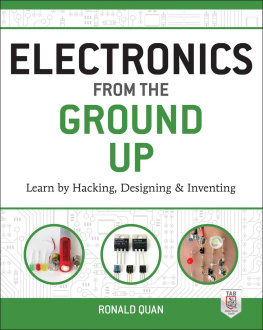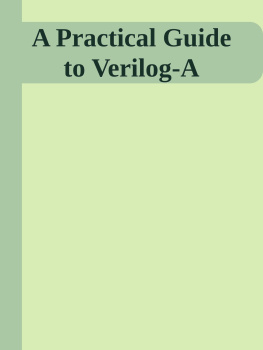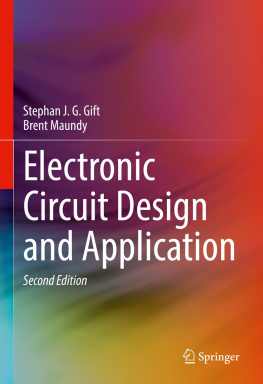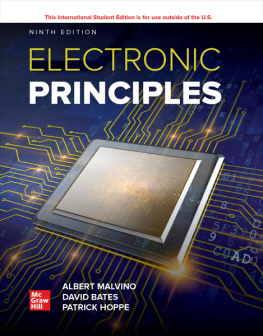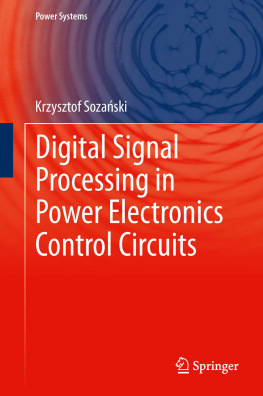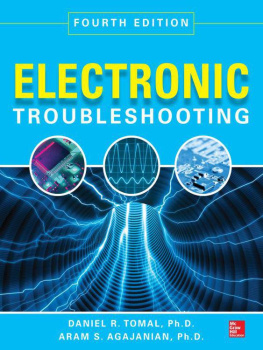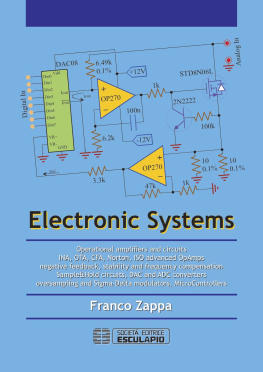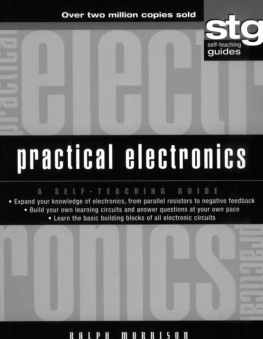Ronald Quan - Troubleshooting Electronic Circuits: A Guide to Learning Analog Electronics
Here you can read online Ronald Quan - Troubleshooting Electronic Circuits: A Guide to Learning Analog Electronics full text of the book (entire story) in english for free. Download pdf and epub, get meaning, cover and reviews about this ebook. year: 2020, publisher: McGraw-Hill Education TAB, genre: Home and family. Description of the work, (preface) as well as reviews are available. Best literature library LitArk.com created for fans of good reading and offers a wide selection of genres:
Romance novel
Science fiction
Adventure
Detective
Science
History
Home and family
Prose
Art
Politics
Computer
Non-fiction
Religion
Business
Children
Humor
Choose a favorite category and find really read worthwhile books. Enjoy immersion in the world of imagination, feel the emotions of the characters or learn something new for yourself, make an fascinating discovery.

- Book:Troubleshooting Electronic Circuits: A Guide to Learning Analog Electronics
- Author:
- Publisher:McGraw-Hill Education TAB
- Genre:
- Year:2020
- Rating:3 / 5
- Favourites:Add to favourites
- Your mark:
- 60
- 1
- 2
- 3
- 4
- 5
Troubleshooting Electronic Circuits: A Guide to Learning Analog Electronics: summary, description and annotation
We offer to read an annotation, description, summary or preface (depends on what the author of the book "Troubleshooting Electronic Circuits: A Guide to Learning Analog Electronics" wrote himself). If you haven't found the necessary information about the book — write in the comments, we will try to find it.
Ronald Quan: author's other books
Who wrote Troubleshooting Electronic Circuits: A Guide to Learning Analog Electronics? Find out the surname, the name of the author of the book and a list of all author's works by series.
Troubleshooting Electronic Circuits: A Guide to Learning Analog Electronics — read online for free the complete book (whole text) full work
Below is the text of the book, divided by pages. System saving the place of the last page read, allows you to conveniently read the book "Troubleshooting Electronic Circuits: A Guide to Learning Analog Electronics" online for free, without having to search again every time where you left off. Put a bookmark, and you can go to the page where you finished reading at any time.
Font size:
Interval:
Bookmark:

Ronald Quan has a BSEE degree from the University of California at Berkeley and is a member of SMPTE, IEEE, and the AES. With a General Radiotelephone license, he has worked as a broadcast and maintenance engineer for FM and AM radio stations, and he also holds an Extra Class amateur radio license. Before becoming a design engineer, he worked in TV-Radio-HiFi repair shops.
He is the author of Build Your Own Transistor Radios (McGraw-Hill/TAB Electronics, 2012) and Electronics from the Ground Up (McGraw-Hill/TAB Electronics, 2014).
For over 30 years he has worked for companies related to video and audio equipment (Ampex, Sony, Macrovision, Monster Cable, and Portal Player). At Ampex, he designed CRT (cathode ray tube) TV monitors and low-noise preamplifiers for audio and video circuits. Other designs included wide-band FM detectors for an HDTV tape recorder at Sony Corporation, and a twice color subcarrier frequency (7.16 MHz) differential phase measurement system at Macrovision, where he was a Principal Engineer. Also at Macrovision he designed several phase lock loop circuits to provide a regenerated clock signal from the raw EFM (eight-fourteen modulation) data stream from a CD player.
At Hewlett Packard, working in the field of opto-electronics, he developed a family of low-powered bar code readers, which used a fraction of the power consumed by conventional light pen readers.
Currently, he is the holder of more than 450 worldwide patents (which includes over 90 United States patents) in the areas of analog video processing, video signal noise reduction, low-noise amplifier design, low-distortion voltage-controlled amplifiers, wide-band crystal voltage-controlled oscillators, video monitors, audio and video IQ modulation, in-band carrier audio single-sideband modulation and demodulation, audio and video scrambling, bar code reader products, and audio test equipment.
Also, he has served as an Adjunct Lecturer and Lecturer in Stanford Universitys Electrical Engineering Department.

Copyright 2020 by McGraw-Hill Education. All rights reserved. Except as permitted under the United States Copyright Act of 1976, no part of this publication may be reproduced or distributed in any form or by any means, or stored in a database or retrieval system, without the prior written permission of the publisher.
ISBN: 978-1-26-014357-7
MHID: 1-26-014357-0
The material in this eBook also appears in the print version of this title: ISBN: 978-1-26-014356-0, MHID: 1-26-014356-2.
eBook conversion by codeMantra
Version 1.0
All trademarks are trademarks of their respective owners. Rather than put a trademark symbol after every occurrence of a trademarked name, we use names in an editorial fashion only, and to the benefit of the trademark owner, with no intention of infringement of the trademark. Where such designations appear in this book, they have been printed with initial caps.
McGraw-Hill Education eBooks are available at special quantity discounts to use as premiums and sales promotions or for use in corporate training programs. To contact a representative, please visit the Contact Us page at www.mhprofessional.com.
McGraw-Hill Education, the McGraw-Hill Education logo, TAB, and related trade dress are trademarks or registered trademarks of McGraw-Hill Education and/or its affiliates in the United States and other countries and may not be used without written permission. All other trademarks are the property of their respective owners. McGraw-Hill Education is not associated with any product or vendor mentioned in this book.
Information contained in this work has been obtained by McGraw-Hill Education from sources believed to be reliable. However, neither McGraw-Hill Education nor its authors guarantee the accuracy or completeness of any information published herein, and neither McGraw-Hill Education nor its authors shall be responsible for any errors, omissions, or damages arising out of use of this information. This work is published with the understanding that McGraw-Hill Education and its authors are supplying information but are not attempting to render engineering or other professional services. If such services are required, the assistance of an appropriate professional should be sought.
TERMS OF USE
This is a copyrighted work and McGraw-Hill Education and its licensors reserve all rights in and to the work. Use of this work is subject to these terms. Except as permitted under the Copyright Act of 1976 and the right to store and retrieve one copy of the work, you may not decompile, disassemble, reverse engineer, reproduce, modify, create derivative works based upon, transmit, distribute, disseminate, sell, publish or sublicense the work or any part of it without McGraw-Hill Educations prior consent. You may use the work for your own noncommercial and personal use; any other use of the work is strictly prohibited. Your right to use the work may be terminated if you fail to comply with these terms.
THE WORK IS PROVIDED AS IS. McGRAW-HILL EDUCATION AND ITS LICENSORS MAKE NO GUARANTEES OR WARRANTIES AS TO THE ACCURACY, ADEQUACY OR COMPLETENESS OF OR RESULTS TO BE OBTAINED FROM USING THE WORK, INCLUDING ANY INFORMATION THAT CAN BE ACCESSED THROUGH THE WORK VIA HYPERLINK OR OTHERWISE, AND EXPRESSLY DISCLAIM ANY WARRANTY, EXPRESS OR IMPLIED, INCLUDING BUT NOT LIMITED TO IMPLIED WARRANTIES OF MERCHANTABILITY OR FITNESS FOR A PARTICULAR PURPOSE. McGraw-Hill Education and its licensors do not warrant or guarantee that the functions contained in the work will meet your requirements or that its operation will be uninterrupted or error free. Neither McGraw-Hill Education nor its licensors shall be liable to you or anyone else for any inaccuracy, error or omission, regardless of cause, in the work or for any damages resulting therefrom. McGraw-Hill Education has no responsibility for the content of any information accessed through the work. Under no circumstances shall McGraw-Hill Education and/or its licensors be liable for any indirect, incidental, special, punitive, consequential or similar damages that result from the use of or inability to use the work, even if any of them has been advised of the possibility of such damages. This limitation of liability shall apply to any claim or cause whatsoever whether such claim or cause arises in contract, tort or otherwise.


This book on troubleshooting analog circuits is intended for the hobbyist, student, educator, or engineer. Because the subject is more into debugging or improving circuits, the book does not require the reader to have an engineering background.
Students who take electronics classes at the technician or engineering level may find this book useful. Some chapters will include basic electronics theory (with some high school algebra). However, we will not be looking for exact calculations when troubleshooting. Instead, approximations will be presented.
Hobbyists who read this book will not only learn troubleshooting techniques. They will also gain insight into why some circuits perform badly. Suggested circuit modifications will be offered to improve the performance of these types of circuits.
Font size:
Interval:
Bookmark:
Similar books «Troubleshooting Electronic Circuits: A Guide to Learning Analog Electronics»
Look at similar books to Troubleshooting Electronic Circuits: A Guide to Learning Analog Electronics. We have selected literature similar in name and meaning in the hope of providing readers with more options to find new, interesting, not yet read works.
Discussion, reviews of the book Troubleshooting Electronic Circuits: A Guide to Learning Analog Electronics and just readers' own opinions. Leave your comments, write what you think about the work, its meaning or the main characters. Specify what exactly you liked and what you didn't like, and why you think so.

